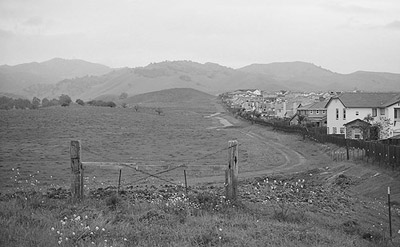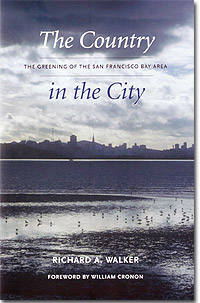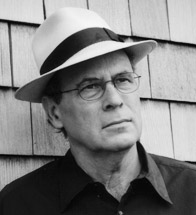Berkeleyan
 |
In his new book, Richard Walker emphasizes the importance of "creating . . . a livable city where the countryside is nearby." The urgency of that effort is underscored by the photo at left, which shows housing encroaching on farmland near Antioch. (Photo courtesy Greenbelt Alliance) |
What's modern planning theory got to do with my day hike?
Geography professor Richard Walker calls the Bay Area 'the leading edge of modern environmentalism.' Much of what it stands for today, he adds, 'came right out of Berkeley'
![]()
| 19 September 2007
From breezy bay to sunny inland oaks, the San Francisco Bay Area is "remarkably blessed with breathing room," declares geography professor Richard Walker. Lucky residents enjoy 3.75 million acres of greenbelt or open water and have only 750,000 acres under buildings and pavement.
 |
Shall we thank nature for these salubrious facts? No, Walker argues in his latest book, The Country in the City (University of Washington Press): "Every park, reserve, and trail required money, mobilization, lobbying, and electoral pressure. So let's clear our eyes about the blessings of nature, and see them through the prescription glasses of human action." Places have their own personalities, Walker says, and the Bay Area has had the nerve and knowledge to chart its own ecological course, sparking parallel efforts worldwide.
At times the prose in this "first comprehensive history of Bay Area environmentalism" is infused with personal passion, as when Walker declares that "protecting the earth - the land, the beasts of the field, the fish of the sea, and, along with them, the health and good sense of the human species - is an absolute." But having ranged widely in what he calls "the undisciplined discipline" of geography for more than 30 years, Walker is also erudite, devoting many pages to jabs at conventional wisdom and interesting arcana. Did you know, for instance, that the area "has been mined for all it's worth," including mercury, coal, manganese, and sulfur, plus a little copper and gold? Or that it was once the world's largest whaling center?
Walker speaks fondly of the experiences that gave him a predilection for this topic, such as touring Western national parks from the back seat of his parents' car and, later, backpacking in the Sierra. The open spaces here are different from those faraway haunts of his youth, however. Constantly co-evolving with the city, they are the rural puzzle pieces of our complex metropolis, says Walker - "as much human- as nature-made, and therein lies their secret pleasure."
As an economic geographer, why did you want to write a book about the environmental movement in the Bay Area?
Partly out of political despair about the election of Bush and [then] 9/11. I was thinking, what can we point to as a counterweight to this right-wing triumph? And I thought, well, here's one area that's had an enormous amount of success. It's not my final word on what we need to do on the environment. But I figured there were some good lessons for the rest of us here about what's possible.
You didn't want to critique environmentalists' strategies?
A lot of the debate around environmentalism has gotten annoying to me, because it's all about, "well, environmentalists are so na´ve and we academics are so sophisticated in our ideology critique." While that's true, and I think it's our function to look at things in the most nuanced way possible, people who are out there fighting for real things can't afford to be so nuanced. They have to get out and fight. That's what people like [Peninsula activist] Florence LaRiviere have done for years. She's saved the entire South Bay and I have written a book. So who's better than whom here? Who's more sophisticated?
The book says that "no place in the country has witnessed more outbreaks of green activism" than the Bay Area. Why is that?
Our generation forgets, because a lot of the land has healed around here, but California has been one of the most devastated landscapes in the world. Not that it's been as abused and worn out as some of the land in China or Europe, but what has happened has happened so fast. So here you have one of the world's great bioregions. And then you come in and you just absolutely rape it for every buck you can get. People really reacted to that. They asked, What is going on here? Can't we do something?
At the same time, the Bay Area was a very cosmopolitan center that developed a sophisticated ideological counterweight to this despoliation. That's what you get with people like John Muir.
 Richard Walker (Photo courtesy Richard Walker) |
You see John Muir as a cosmopolitan person?
Absolutely. This was no Grizzly Adams. Muir was a clever mechanical engineer. Then he suffered a devastating eye injury, gave that up, and started traveling around South America and the United States. Then he developed his science. He founded the Sierra Club - which was businessmen and university professors at Stanford and Berkeley - and went on to do some tremendous work in glaciology, ecology, and botany. He was also a great writer. He crossed the chasms between the urban intelligentsia and the people out in contact with nature.
Muir loved pristine landscapes. But your book reminds us not to forget about the places where people's livelihoods and nature intersect.
There is still this ongoing debate within environmentalism about pristine wilderness landscapes and ruined urban landscapes. It's a simple kind of black-and-white dualism. A major point of this book is to befuddle those categories, to rethink those categories around the city, creating a livable countryside in the city and a livable city where the countryside is nearby.
At one point you say that Golden Gate Park, a Bay Area open-space gem, is as transformed as "a freeway underpass or Disneyland."
Yes, Golden Gate Park is sitting on what were once probably some of the greatest sand dunes in the world. But at the time they were regarded as a wasteland. The idea was to plant them so they looked like England, or at least the Northeast. It's completely artificial.
What does that say about the park's value?
It doesn't say anything, really. We reconfigure things all the time. This house that we're sitting in is reconfigured wood - probably redwood and Douglas fir, because it's pretty old. And that doesn't make it a horrible thing. It's a cute little house. We can also do that when we make parks. And that doesn't make them any less as parks.
Do you support setting aside some lands as wilderness?
I'm an old believer in wilderness - of taking some of these least-touched lands and setting them aside, and not screwing around with them. But there are some worked-over landscapes that you can still get lost in, where a lot of animals can thrive, and I say hallelujah to setting them aside, too.
In several places, you compare the environmental movement to the modernist movement. What does modernism have to do with these battles?
Sociologists in particular have said that environmentalism is part of the postmodern era, interested in diversity, hybridity, identity, and so forth. They say that it has nothing to do with old Labor or old Marxism, or the New Deal for that matter. And that's just not true when you look at the roots of environmentalism in the Bay Area: The great upsurge happened not only in the '60s but before that. About the same time you were getting inklings of the New Left in the late '50s, you were getting inklings of this new environmentalism. And it just exploded after that. So that's one part of it.
The other part is the Bay Area's profound vision of the greenbelt, and how you could meld city and country was promoted by people like Jack Kent and [Berkeley IGS researcher] Mel Scott. These people were modernists. They were steeped in modern planning theory - the idea that you can sit down with some enlightened experts working for the social good and plan how the cities ought to grow.
What's a "postmodern" environmental philosophy?
The postmodern critique is that modernism is associated with the arrogance of a small elite of white-male Europeans and a kind of rationalism that is not the way human beings really work. It's essentially anti-democratic. It's top-down planning by an elite. There is a lot to that critique.
On the other hand, when you are living in America - where land-planning is anathema and we just destroy our land with chaotic, profit-driven, exploitive, extractive development - planning means having some social control, some social thought, some social benefit connected with urban growth. That is the great idea behind modernist growth. If you could combine that with democratic input, you'd really have something.
Where do you stand ideologically?
I've always liked calling myself a Marxist, because as a kid I grew up in a country in which to say that was to be a pariah. But my leftism is very much a Bay Area/California leftism in which, for a very long time, communists, anarchists, feminists, and environmentalists have rubbed shoulders. Here, purity of position has been rare. At the same time, I like to think I'm quite a reasonable person who doesn't think he's got the one truth, who's committed to scientific inquiry - a good, anarchic American liberal.
What were the biggest surprises for you in researching the book?
One was the importance of environmentalism on the Peninsula, where I grew up: I didn't realize how wide and deep and rich that was. Another was the story of Sonoma, a multi-racial, multi-class, multi-interest county that turns out to have this incredibly complex politics and history of environmentalism and open space.
Another surprise is the amount of enthusiasm for parks coming from people of color. In the last election, the most votes for park bonds, proportionally, came from Latinos. The second-most came from African Americans, and the third-most from Asians. And white people are in the back. In many political arenas that would be expected - white people are the most regressive these days in California. But I wouldn't have thought that would be true when it came to parks.
Another surprise was how big the bay-marshland-restoration movement was. The most advanced marsh-restoration work in the world is being done here.
Your book also discusses the important role women played in the Bay Area's environmental movement. Was that a surprise?
I had an inkling of it. I knew there were a lot of women. And I knew I wanted to get away from the Great Man theory of history. I like to play it up to audiences, though sometimes it's an exaggeration. There were a lot of men, too. But men get most of the credit.
One of the book's more controversial claims is that the Bay Area fueled the movement for parks nationally - that we started it all.
My overall claim is that the Bay Area was probably the leading edge of modern environmentalism in the world. I think it's a claim that holds up; I've defended it in detail and drawn the comparisons. The National Park Service program, for instance, starts here. It was started by Cal grads, with meetings in the Bay Area. Of course, it's connected with some key players elsewhere, in Chicago, Washington, and New York. But the group of guys - Stephen Mather, Horace Albright, and their followers - came right out of Berkeley.
A San Francisco Chronicle reviewer said your book was "smug." What do you say?
The Bay Area may be smug, but why take it out on me? It reminds me of the opposite of one of Winston Churchill's statements about his political opponents: "He was a modest man with a great deal to be modest about." Of course, Churchill was an arrogant man with a lot to be arrogant about. And the Bay Area is a smug place with a lot to be proud of. From food, to hiking, to gay alternative blowouts - we have a wonderful culture and a wonderful place to live.
Okay, now you've done parks. What's your next book going to be about?
The urbanization of the San Francisco Bay area - the pavement part.
Joan Hamilton is the former editor-in-chief of the Sierra Club magazine, Sierra.

